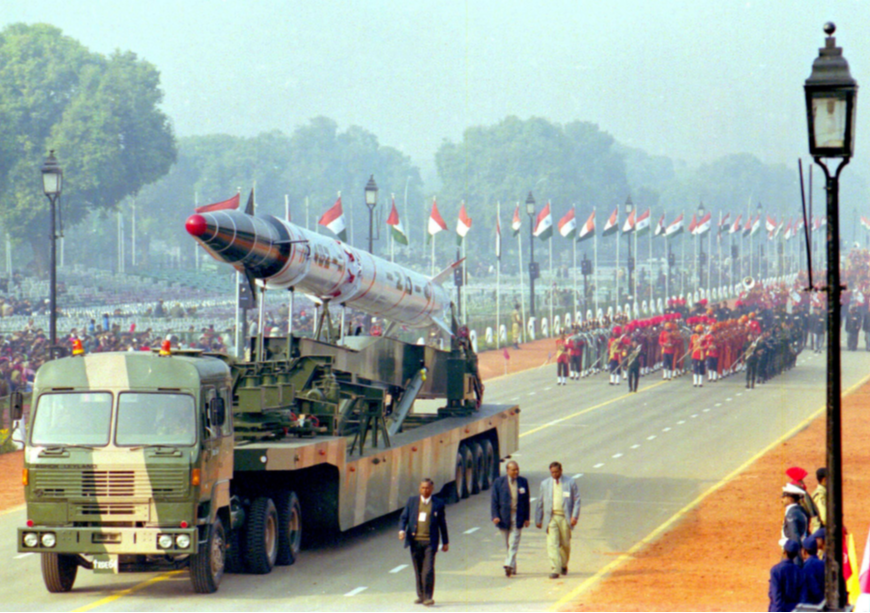-
CENTRES
Progammes & Centres
Location
There is a crying need to have a fresh look at BMD and design solutions to counter the growing issue of cost asymmetry.

The first recorded use of a ballistic rocket as a weapon was in 1232 when the Chinese and the Mongols were at war. What was used at the time was a simple solid-fuelled device with gunpowder as a propellant. The weapon has since evolved and has taken on many forms. It gained widespread use during World War II in the form of the V2 rocket which was used extensively by the Germans. Though destructive and at the time, impossible to intercept, due to the limited numbers produced as well as technical limitations pertaining to accuracy, it did not produce the strategic impact desired. With the invention of nuclear weapons coupled with the accentuation of hostilities between the Soviet Block and the West, the rocket acquired a new role, this time as a strategic weapon for carrying a weapon of mass destruction. Given the importance of this task, considerable effort was made to enhance its range, accuracy, and reliability.
As strategic nuclear missiles acquired greater capabilities, research on defences against them also started to gather steam. However, given the complexities and associated costs involved in hitting small targets of this nature moving at exceptionally high speeds, both the belligerent parties of the Cold War decided to ensure strategic stability by placing mutually acceptable constraints on their development—an approach that was soon institutionalised through the signing of the Anti-Ballistic Missile (ABM) treaty in 1972.
However, as the technological disparity between the United States (US) and the erstwhile Soviet Union grew over the next few decades, some influential US decision-makers believed that the ABM treaty was biased against them. This school of thought was based on the assumption that while the US had the capacity and capability to field Ballistic Missile Defence (BMD) systems of increasing sophistication, the USSR did not. This approach was mainstreamed during the Reagan administration through the launch of the Strategic Defence Initiative (SDI) which through some creative interpretation of the ABM treaty articulated that the proposals under the initiative were consistent with the US obligations under the framework of the treaty. This veneer was shed in 2001 under the Bush administration through the unilateral withdrawal from the treaty.
Over the years, several BMD systems have been developed by the US, the best-known ones being the US Army-operated Terminal High Altitude Area Defence (THAAD) and Patriot systems, the US Air Force-fielded Ground Based Interceptor (GBI) and the US Navy-operated Aegis BMD system. Such capabilities have proliferated to other countries as well, either through the acquisition of US-designed and produced systems or through domestic Research and Development (R&D) to produce similar weapons. Several countries have followed an evolutionary approach in this respect, wherein the capabilities of existing Air Defence Systems have been substantially enhanced to meet the ballistic missile threat.
Over the years, several BMD systems have been developed by the US, the best-known ones being the US Army-operated Terminal High Altitude Area Defence (THAAD) and Patriot systems, the US Air Force-fielded Ground Based Interceptor (GBI) and the US Navy-operated Aegis BMD system.
The degree of difficulty involved in hitting a small, high speed and at times manoeuvring ballistic warhead is enormous. Typically, a BMD system uses powerful phased array radars for detection as well as tracking. It thereafter launches an interceptor that has sufficient propellant to take it to the desired range and height of impact. Interceptors often have to use thrusters as the rarefied air at high altitudes makes control surfaces ineffective. Guidance systems must cater for closing velocities that, more often than not, are in double-digit Mach numbers. It, therefore, comes as no surprise that BMD systems are enormously expensive. As an example, the reported cost of a Raytheon-manufactured Standard SM-3, Block 1B missile is US$36.387 million. However, given the fact that such weapons were designed to bring down strategic nuclear weapons with enormous destructive potential, the expense of doing so was considered well justified.
There have, however, been fresh developments over the last decade. Costs sunk in the development of rockets designed to carry strategic nuclear warheads are now increasingly being recouped through their use as vehicles for conventional weapons. While there are some gold-plated high-end programmes for doing so such as the US-funded Conventional Prompt Strike programme that is designed to deliver ordinance in any part of the globe with a time-late of less than 60 minutes, many low-end ballistic missiles of increasing capability have either already been fielded or are in different stages of development in different countries. A family of weapons in this respect pioneered by China is the Anti-Ship Ballistic Missile (ASBM). The engineering complexity related to mounting an effective seeker on a Ballistic warhead with the associated control system that allows it to detect, possibly identify, and manoeuvre itself to hit a moving target at sea appears to have been resolved. Further, reports that such weapons are now being even made by countries such as Iran and fielded by relatively untrained militant groups such as the Houthis portends an era of democratisation of the ballistic missile as a weapon of choice.
China’s growing prowess in this field has been demonstrated by the production and deployment of an increasing number of ASBMs of the DF-21D and DF-26 classes. The DF-26 has an assessed range of 4000 km which puts facilities at Guam within range. It lies at the top of the food chain of their Anti-Access Area-Denial (A2AD) architecture that puts at risk any platform that comes within striking distance from their coastline. Chinese literature itself has often referred to this weapon as Shashoujian or Assassin’s Mace, which essentially underscores its potential game-changing nature.
The increased adoption of sophisticated commercially available technologies as well as the economics of scale will bring down the costs of ballistic missiles even further. On the anvil also lies the increasing proficiency of reusable rockets as demonstrated by SpaceX in the first stage of the commercial Falcon 9 rocket as well as its boosters. Weaponisation of such a capability which will allow a rocket to be used repeatedly to launch conventional warheads on ballistic trajectories thereby bringing down the cost of fielding such weapons by several orders.
The increased adoption of sophisticated commercially available technologies as well as the economics of scale will bring down the costs of ballistic missiles even further.
The current approach to combat the growing threat posed by conventional ballistic missiles has primarily been based on the use of existing BMD interceptors. Missiles such as the Standard SM 6 used by the Aegis system have been designed, to an extent, to intercept ballistic missiles as part of the US BMD architecture. They are, therefore, well capable of meeting the threat posed by more rudimentary ballistic weapons in the arsenal of countries such as Iran or North Korea. Acceptance of this one-size-fits-all approach has been exemplified by the remarks made by Admiral Aqilino, Commander, U.S. Indo-Pacific Command, who while testifying to Congress on 20 July 2024 stated that “I don’t care what tracks it, I don’t care what shoots it, we just got to hit it.”
The above approach while good in theory, is not sustainable. Given the enormous and growing asymmetry in cost between ballistic missiles and interceptors, one can only expect that in conflicts ahead, such weapons will be used in growing numbers. Using highly sophisticated interceptors to engage low-cost conventional warheads launched in increasing numbers is a losing proposition in terms of cost as well as on one’s ability to regenerate and reequip platforms with have expended such defensive munitions. At the very least, it will require defending platforms to be pulled out of the theatre and travel to possibly distant bases for rearming.
Given the enormous and growing asymmetry in cost between ballistic missiles and interceptors, one can only expect that in conflicts ahead, such weapons will be used in growing numbers.
There is, therefore, a crying necessity to have a fresh look at BMD and design solutions to counter the growing issue of cost asymmetry. Threat mitigation measures will therefore need to be redesigned so that while they continue to be effective, they are also easily regeneratable and most importantly, inexpensive. This can only happen if Commanders in the field shed their disdain for the more mundane matters pertaining to the economics of war and place a strong demand on force providers for solutions that are robust and persistent enough to meet the soon-to-be-all-pervasive threat of the conventional ballistic missile.
Monty Khanna(retd.) is an awarded submariner who specialised in Navigation and Direction and served as the Naval Attach at the Embassy of India Washington D.C.
The views expressed above belong to the author(s). ORF research and analyses now available on Telegram! Click here to access our curated content — blogs, longforms and interviews.

Rear Admiral Monty Khanna was commissioned into the Indian Navy in Jan 83. He won the `Best Naval Cadet’ award and Midshipman `Sword of Honor’ ...
Read More +